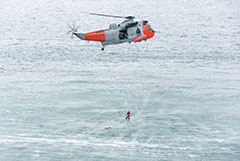
 People shouldn't die because their boat capsizes. Yet hundreds of people, some seeking a better life and others who just run into trouble with their own boats, die every year because they aren't found in time. Search teams rely on currents and weather to predict where people will drift, but currents are highly variable and often push both people and objects far away from where the rescuers expect them to be. Using a new technique based on differential equations, researchers have identified strong curves of attraction that develop near coasts, "Transient Attracting Profiles," nicknamed TRAPs, along which objects accumulate in the short term. In ocean field experiments simulating an accident, objects accumulated on TRAPs as predicted and were found in two to three hours.
People shouldn't die because their boat capsizes. Yet hundreds of people, some seeking a better life and others who just run into trouble with their own boats, die every year because they aren't found in time. Search teams rely on currents and weather to predict where people will drift, but currents are highly variable and often push both people and objects far away from where the rescuers expect them to be. Using a new technique based on differential equations, researchers have identified strong curves of attraction that develop near coasts, "Transient Attracting Profiles," nicknamed TRAPs, along which objects accumulate in the short term. In ocean field experiments simulating an accident, objects accumulated on TRAPs as predicted and were found in two to three hours.
This new approach combines techniques from dynamical systems with real-time data and has many advantages over traditional methods. Perhaps most importantly, since ensuring a short rescue time is crucial, the TRAPs can be calculated very quickly from data derived either from models or remote sensors. Also, they are very robust in that a small uncertainty in the data—such as the location of the accident—will not greatly affect the TRAP where people will end up. Finally, in the experiments at sea, different sizes and types of objects all collected along the curves. TRAPs will soon be tested in other experimental trials. In the future, they may be used to track oil spills quickly.




 People shouldn't die because their boat capsizes. Yet hundreds of people, some seeking a better life and others who just run into trouble with their own boats, die every year because they aren't found in time. Search teams rely on currents and weather to predict where people will drift, but currents are highly variable and often push both people and objects far away from where the rescuers expect them to be. Using a new technique based on differential equations, researchers have identified strong curves of attraction that develop near coasts, "Transient Attracting Profiles," nicknamed TRAPs, along which objects accumulate in the short term. In ocean field experiments simulating an accident, objects accumulated on TRAPs as predicted and were found in two to three hours.
People shouldn't die because their boat capsizes. Yet hundreds of people, some seeking a better life and others who just run into trouble with their own boats, die every year because they aren't found in time. Search teams rely on currents and weather to predict where people will drift, but currents are highly variable and often push both people and objects far away from where the rescuers expect them to be. Using a new technique based on differential equations, researchers have identified strong curves of attraction that develop near coasts, "Transient Attracting Profiles," nicknamed TRAPs, along which objects accumulate in the short term. In ocean field experiments simulating an accident, objects accumulated on TRAPs as predicted and were found in two to three hours.
 Korean
Korean Polish
Polish